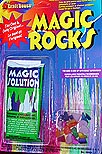

MAGIC ROCKS! What they are, how they work, and experiments with them.
(Click on main site to browse 70 other topics ranging from exotic kaleidoscope designs to the strange world of lucid dreaming.)
PLEASE SEE THE BOTTOM OF THE PAGE FOR A BIG UNDATE!!!

Magic rocks have been around for decades, I can remember playing with them when I was a child forty years ago.
In February, 2005, I received an email from Ann who let me know that Magic Rocks were invented by two brothers, James and Arthur Ingoldbsy, in the Los Angeles area in 1940. Magic Rocks are currently being manufactured in Sheridan, WY by James' son, Rick Ingoldsby. (Thanks, Ann!)
A typical package of Magic Rocks contains an envelope of liquid sodium silicate and a small handful of colored rocks that are chunks of water soluble metallic salts. Prices in 2004 ranged from as little as three dollars in discount stores to as much as six dollars in stores catering to teachers and students. Some kits come with figurines to give the crystal garden a more exotic look.
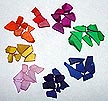
The rocks come in eight colors: white, yellow, orange, dark orange or red, magenta, green, blue and purple. The most common colors in the half dozen kits I got for this page were white and green. The rarest were the oranges. The colors of the spires that grow out of these rocks is slightly fainter than the rocks themselves.
![]()
If you look carefully at the edges of the rocks, many show a darker layer. I suspect that this indicates that these rocks are chemically mixed in vats then poured out into shallow trays to dry and harden. Settling occurs with the darker color falling to the bottom.
The following instructions are only approximate. If you've lost your instructions, you should purchase a new kit and read the instructions in it completely. Magic Rocks makes use of hazardous chemicals and should only be used under knowledgeable adult supervision.
To make Magic Rocks work, mix the liquid in the packet with 1 and 1/2 cups of 70-degree water (for kits with 2.5 ounces of growing solution) in a three-inch wide jar or glass (The mixture needs to be 4 to 5 inches deep), add one half of the rocks, let them grow for six hours into three-inch tall columns, pour off the liquid to remix it (Sodium silicate is much heavier then water and tends to separate and collect on the bottom of the jar.), pour the solution back into the growing jar, add the second half of the rocks, and let them grow. (Some instructions recommend growing them in thirds.) Then discard the liquid, carefully rinse the columns and store with the jar full of water.
It's recommended to cover the surface on which you'll be mixing the solution with wax paper, plastic wrap or aluminum foil and not to use newspapers or wood cutting boards. The solution can stain so clear up spills immediately. Large pieces of the rocks that go into the solution should be broken into 1/4 to 1/2-inch pieces.
After the second, or third, growing period, some instructions recommend pouring off the sodium silicate solution, remixing it, and pouring it back into the jar for another six hours. Since the growing is complete, I can only guess that this last step helps strengthen the growths.
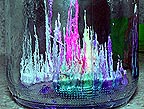
The end result.
How they work
When one of the rocks (pieces of metallic salt) is dropped into the sodium silicate (an acid) solution, the surface dissolves and combines with the sodium silicate to form a gelatin. This gelatin stops the sodium silicate but allows water through to dissolve more of the rock. This water, now containing dissolved metallic salt, is lighter than the gelatin and surrounding water so it rises, pushing its way through the gelatinous coating. As soon as it comes in contact with the sodium silicate in the water it forms more gelatin, this time on top of the first layer of gelatin. The process continues with water seeping through the gelatin, dissolving more rock, rising, and being gelatinized. Eventually the entire rock is consumed and the process stops. (During the rinsing step, you can look down and often see that the spires have grown in a ring around the rock and that the center of the ring, where the rock was, is completely empty.)
During this process, the gelatin slowly firms up. The spires are then stable and can be rinsed and stored. Prior to this point they are extremely soft and moving the jar can create currents, which bend the spires. After they harden they remain in this bent shape. This can create interesting shapes but they are much more easily broken.
Breaking
the Rules
The instructions that come with the Magic Rocks admonish users to avoid placing too many rocks in the jar at one time, to space the rocks so they don't touch, to break large rocks up into 1/4 inch pieces, to only use glass jars because the spires won't grow on plastic, and to make sure the liquid level is four inches deep.
Why?
That's what I wanted to know so I performed a series of experiments to see what happens if you break some of these rules.
What happens if you place too many rocks in the growing solution at the same time?
A cloudy residue collects on the bottom of the jar. I thought it looked kind of neat, like fog. The trouble is that it washes away in the rinsing process.
What's
the difference between setting the rocks apart or
having them touching?
Set slightly apart, each rock grows one to three inches tall. If they are touching they grow taller and can reach the surface. If this happens the gelatin spreads out and the spire becomes top heavy and will break off when rinsed.
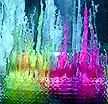

...not touching......touching
What happens if you make the liquid deeper and add a pile of rocks all of which are touching?
You get almost a solid column of growth which can be quite strong, for Magic Rocks, if it doesn't reach the surface of the liquid is only four times as tall as it is wide.

What happens if you purposely grow Magic Rocks in liquid that's so shallow that even though the top of the spire spreads out on the surface the spires are short enough to support it?
What happens is that you get a stable shelf on which you can place a second layer of Magic Rocks. Then if the liquid level is increased these secondary growths along with the initial spires create very interesting shapes.
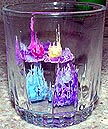
Why do the instructions say that Magic Rocks won't grow in plastic?
Because the instructions are poorly worded. As the picture below of a spire grown on a piece of Plexiglas demonstrates, they grow great on at least this kind of plastic.
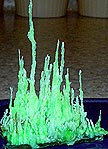
Magic Rocks grow great on plastic, the problem is that they won't grow onto it. They can't stick to plastic. They slide right off. This should be easily corrected by using coarse sandpaper to roughen the surface.
What
happens if you use pieces of rock that are larger or smaller than
the 1/4 inch sized recommended by the instructions?
I grew spires from all different sized rocks and the quarter inch size consistently produced the strongest, best looking spires. Large pieces sometimes didn't use up all of their material. Piles of very small pieces sometimes hardly grew at all and other times produced uninteresting mounds.
What
happens if you use very hot water instead of the recommended 70
degree F. water?
The spires grow a little faster and 25 percent taller.
Do
each of the three growing steps grow to the same height?
No. Each time the solution is used it looses potency. The third time around the rocks I experimented with only got 1 inch tall instead of the three inches attained during the first growth.
How
long will Magic Rocks last?
Rinsed and stored in water I find that a cloudy haze formed on the bottom of the jar in just two days but the spires lasted for weeks. Stored without water in a closed jar, the spires last almost as long and are clearer to see, but are more fragile. Stored out in the open the spires start to turn white in a week and begin to crumble. The rate at which this happens depends on the humidity.
I hope you've enjoyed this page. And Remember, don't be afraid to experiment with your Magic Rocks. You never know what you might discover.
If you can't find Magic Rocks at your local toy store, variety store or supermarket (I found mine in a Stator Brothers), here are a few on-line sources. I've never purchased from these companies so I can't attest to the quality of their service.
IMPORTANT UPDATE!!!
A decade after creating this page I decided to update it with several videos. The first provides additional background information as well as four time lapse videos demonstrating magic rock growth in high speed. The second and thrisd videos are additional time lapse videos. I hope you enjoy them.
Shrink
Magic: http://www.shrinkmagic.com/html/product.asp?ProductID=17
Auspix Scientific: http://www.auspexscientific.com/magicrockskit.html
Explore 4 Fun: http://explore4fun.com/magicrocks.html
Miles
Kimball:
http://www.mileskimball.com/jump.jsp?itemType=PRODUCT&iProductID=3364
And Amazon.com, of course.
Return to the main page for 50 other topics